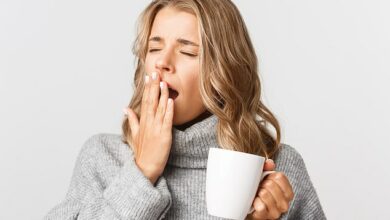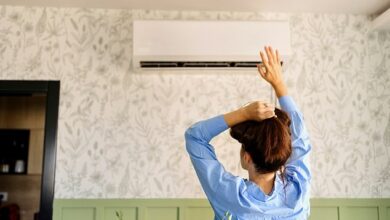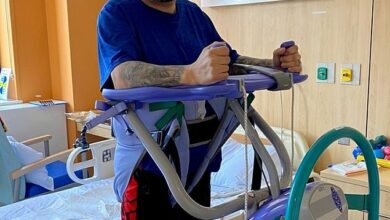I tried the viral mouth tape trend to help me sleep, but was it worth it?
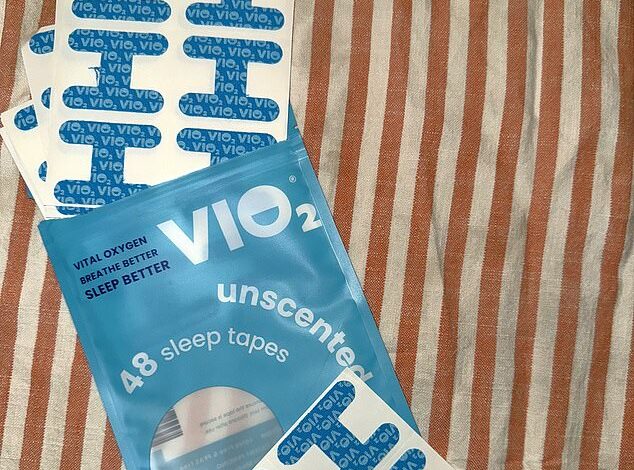
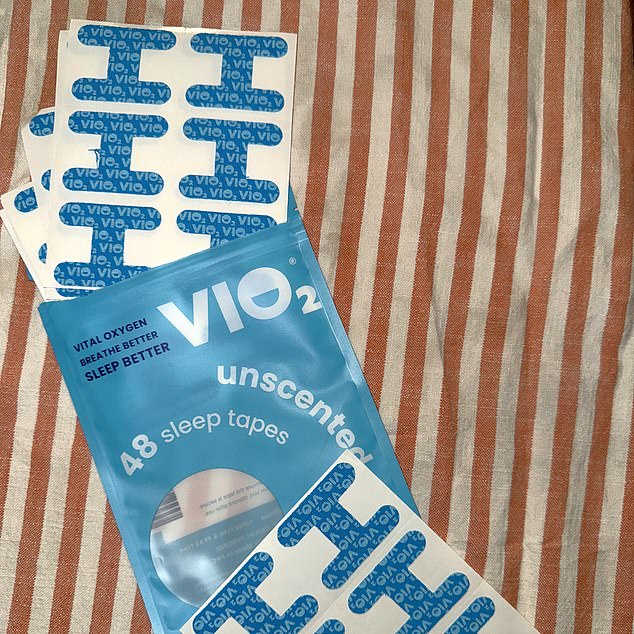

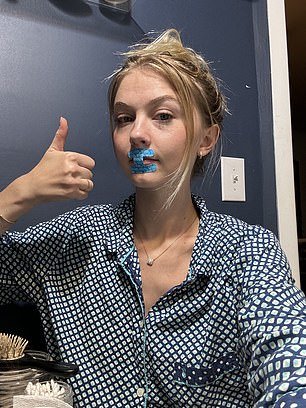



For me, sleep is sacred. Most nights I get to bed early and sleep heavily, without interruptions.
Yet, as a health reporter who delves into the world of wellness trends, I’m told there are ways to get even more out of my eight hours by doing one simple thing: taping my mouth shut while I sleep.
As a nighttime mouth breather and occasional snorer, I could be at greater risk for gum disease, dry mouth, and cavities, and I’ve seen countless videos on TikTok telling me what the only thing standing between me and my dream face is – one without bags under the eyes and with a sharp, supermodel jaw – was my sleep routine.
So during the month of October, I slept with an H-shaped piece of cotton-blend medical tape over my mouth, with the goal of reducing my mouth breathing at night.
Advocates, especially those in alternative medicine, say mouth taping has numerous benefits. Some include: improved sleep, increased energy, reduced allergies, reduced puffiness, and better tongue posture, which can reportedly help create a more defined jawline.
Traditional medicine says none of these benefits have been proven in the laboratory.
Dr. Jamie Winn, the medical director of Universal Drugstore, told me that taping my mouth to sleep at night had no scientific basis. He advised against its use to prevent snoring and said anyone using it for that purpose should consult a doctor first.
Dr. Winn said: ‘Most of the evidence supporting the benefits of mouth taping is based on personal anecdotes or extremely limited studies. There is not enough strong scientific evidence to confirm its effectiveness.”
So at best I could wake up with a new face. At worst, the tape could be a rip-off and ruin my sleep.

The cotton blend of the mouth tapes was soft and the glue used is strong but not difficult to remove. I felt like there was a residue left around my mouth

Vio2 is just one of many brands offering medical-grade mouth tape. The price, which is $24.95 for a pack of 48 mouth tapes, is fairly standard compared to other competitors
Still, despite the skepticism, I was full steam ahead. When I opened my $24.95 package of 48 mouth tapes, I found the instructions clear.
The packaging states that the tape can be worn to “train athletes to breathe properly, give you a good night’s sleep, or even help your partner reduce mouth snoring.”
Dr. David Shaker, a doctor of osteopathy, a qualified doctor who practices both holistic medicine and conventional techniques, said there are clear benefits to breathing through the nose: ‘I wouldn’t overlook the nose – nasal breathing is great for you .’
Breathing through your nose during the day can increase oxygen levels in the lungs, slowing absorption and lowering blood pressure, making you feel calmer and increasing oxygen flow, he said.
Dr. Chelsea Perry, a sleep specialist and dentist based in Massachusetts, added that breathing through your nose reduces the risk of developing dry mouth, gum disease and cavities.
So, she said, mouth taping may have benefits for some people, but it’s not right for everyone, especially those who have trouble breathing through the nose.

You have the option to wear the mouth tape vertically (photo) or horizontally over your mouth. Dr. Shaker does not recommend wearing it horizontally as this may block the emergency airflow through the mouth
Still, Dr. Perry said, “Theoretically, you could get all these benefits [from mouth taping]. But the studies on mouth tape are so limited that it is difficult to say.’
Still, I persevered.
On the first night, after doing my skincare routine, I gently applied the mouth tape to my lips and went to bed at 10:30 PM.
The glue stayed on my skin despite the layers of cream I applied to it, which was a plus.
But I immediately started thinking about what would happen if I wanted to drink water, or if my roommate came in to talk.
I told myself these were stupid questions and tried to settle down.
Before long, my attempts to calm my mind were replaced by a genuine sense of claustrophobic panic — I didn’t realize how much I relied on my mouth.
Dr. Perry said of all her concerns, “Claustrophobia is definitely a big one.”
After about 30 minutes of tossing and turning and deep breathing through the nose, I finally fell asleep. Then I woke up at 4am and couldn’t fall back for about 15 minutes.
I hardly ever wake up in the middle of the night.
I was tempted to rip the tape off, but stubbornly imagined the new jawline TikTokers said I would have and was determined to leave the tape on.
But Dr. Shaker said people should never place a piece of tape horizontally over their mouth while sleeping, because you could completely block airflow.
Oops, my bad.


Before I started the month of mouth taping, I was hoping to see some improvements in jaw shape. Unfortunately, I didn’t notice any significant differences in my jaw after I finished taping the mouth
According to the instructions on the back of my VIO2 tape, I had tried placing the tape over my lips both horizontally and vertically. I found the horizontal position, where my mouth was essentially closed, to be more comfortable.
It’s true that if you have trouble breathing through your nose and your mouth is taped while you sleep, you will probably wake up and be able to remove the tape from your mouth.
But in the long run, this will disrupt your overall sleep quality every night.
It is therefore better to use the tape vertically over your mouth, so that air can come around the sides if you need it. There are also some brands of tapes with holes in the middle.
This is the same concern doctors have for people with undiagnosed sleep apnea. Sleep apnea is a condition in which interruptions in your nighttime airflow cause you to wake up frequently during the night.
Although it sounds harmless enough, in the long term it increases the risk of stroke, heart disease and heart failure, and poor sleep quality can cause depression, mood swings and irritability.
I tried applying the tape vertically to my mouth, but found that it didn’t change my experience, and that I actually felt more comfortable with it sitting horizontally on my lips.
In the morning, removing the tape from my mouth was not painful, but it was unpleasant. As a person with sensitive skin, I cringed at the pulling sensation and tried to gently rub away the remaining glue with water.
On the plus side, though, I didn’t have morning breath.
This exact pattern continued every night for the entire week: panic, sleep, wake up, panic, fall back asleep, wake up groggy.
By day 10, I wasn’t waking up in the middle of the night anymore, and my first move in the morning wasn’t removing the tape from my lips, so I guess I was getting used to it. Still, I certainly didn’t feel more energetic.
My diary entry from that day reads, “I’m so sleepy today. Cannot focus. Must work. It feels like I’m moving through jello… I woke up with a big juicy white head on my chin next to the flap of the bandage – coincidence?’

Supermodel Ashley Graham revealed she has started taping her mouth shut before falling asleep at night. There are many different brands of mouth tape and Graham appears to use medical tape. Other celebrity advocates include Gwyneth Paltrow and Jimmy Fallon
The next week I had small, angry pimples on my chin and lips. Mouth tape can cause skin irritation and clogged pores, which can lead to breakouts, according to Curology.
Clearly.
Dr. Shaker wasn’t concerned about my skin, but he noted that the mouth tape could cause a more serious condition.
In severe cases, Dr. Shaker said he was concerned about the likelihood of people developing something called aspiration pneumonia — a scenario that occurs when vomit or spit cannot leave the mouth and is instead inhaled, infecting the lungs .
With this worry plaguing my mind, I skipped the mouth tape on nights after I’d had a few drinks, terrified of choking on my own vomit.
Still, I came back during the week, convinced that if something bad happened that night, it would probably wake me up and I could quickly remove the tape.
It was more or less the same for the rest of the month. My acne persisted, my sleep had stabilized, but I was tired.
I still had hope that one day I would wake up with an Adonis jawline.
Dr. Perry unfortunately dashed my hopes by saying, “Unfortunately, short of surgery, you won’t really change the shape of your jawline.”
At the end of my month I felt and looked more or less the same, just a little stickier around the mouth.
If you’re interested in trying it out, both doctors I spoke to said you should see a doctor first to rule out underlying conditions that could make it harder for you to breathe at night.
I didn’t see any benefit to taping the mouth, but they said it’s possible it might work for others too.
Dr. Perry said, “If everything is clear, then you have a blessing to try. You know, see what works for you, as long as you’re really taking those precautions, right? You don’t want it to be harmful.’


